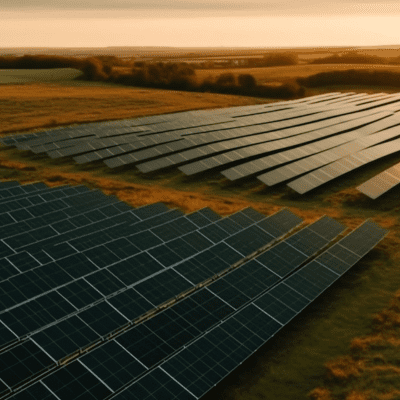OUR GREEN PORTFOLIO
Stay Connected With Clean Energy Trends
SOLAR FARM
 These photovoltaic systems are made up of multiple solar panels arranged in an open space, often in a large area known as a solar farm. The main goal of these solar farms is to make the most of the available sunlight to generate electricity in a sustainable way.
These photovoltaic systems are made up of multiple solar panels arranged in an open space, often in a large area known as a solar farm. The main goal of these solar farms is to make the most of the available sunlight to generate electricity in a sustainable way.
Solar energy has transformed the way we access electricity in our homes and communities. In this context, solar farms are an essential part of the energy transition, by providing a renewable energy source that contributes to reducing polluting gas emissions and moving towards a more environmentally-friendly energy system.
Solar farms work by capturing solar energy through photovoltaic panels, which contain solar cells that convert sunlight into electricity.
When sunlight hits the panels, the solar cells generate direct electrical current. An inverter then converts this direct current (DC) into alternating current (AC), which is the form of electricity used in most homes and businesses.
In short, a solar farm is a renewable energy source that does not emit carbon dioxide (CO2) thanks to its environmentally-friendly production process. Converting solar energy into electricity is a clean process, without Greenhouse Gas (GHG) emissions.
A solar park’s income derives from the sales of electricity to the grid, and so its output is metered in real-time with readings of its energy output provided, typically on a half-hourly basis, for balancing and settlement within the electricity market.
Solar Park’s also can earn revenue from carbon markets by selling their carbon credits. In fact, utility-scale energy producers know all about carbon credits and build their power agreements to include them.
SOIL CARBON


“Soil carbon” refers to the organic carbon contained within soil. This carbon is crucial for soil health, as it aids in nutrient cycling, water retention, and promoting biodiversity. Soil carbon is primarily derived from decomposed plant and animal materials. Changes in land use and management practices can influence soil carbon levels, which in turn impacts the environment and climate change.
Soil carbon is present in two forms: inorganic and organic. Soil inorganic carbon consists of mineral forms of carbon, either from weathering of parent material, or from reaction of soil minerals with atmospheric CO2. Carbonate minerals are the dominant form of soil carbon in desert climates. Soil organic carbon is present as soil organic matter. It includes relatively available carbon as fresh plant remains and relatively inert carbon in materials derived from plant remains: humus and charcoal.
Enhancing soil carbon levels boosts soil performance, with benefits like enhanced water retention and nutrient supply. This can lead to more robust and resilient crops and pastures, ultimately increasing the profitability of the farming operation.
We will implement landscape appropriate management strategies to generate soil carbon credits by:
• Overcoming a soil constraint (e.g. acidity, sodicity, hard setting soils)
• Soil nutrition, including precision agriculture
• Pastures: new pastures, pasture rotation and on-demand legumes
• Cover cropping or pasture cropping
• Reduced tillage
• Grazing management
• Rehydration work (e.g. ponds and banks)
FORESTRY CONSERVATION


Forest conservation’s carbon credits are viewed as an effective method to combat climate change. This approach allows businesses and individuals to offset their own carbon emissions by compensating for them.
Forest conservation’s carbon offset initiatives encompass a range of activities such as restoring forests, safeguarding at-risk trees, and enhancing forestry practices to boost carbon absorption. The value of these projects is determined by their capacity to capture carbon and deliver additional environmental advantages that would not occur without intervention.
BIOCHAR


Biochar production can vary from low-tech methods to high-tech systems, with the potential to serve additional purposes like drying feedstock or generating electricity in advanced setups. Its applications extend beyond soil improvement, including construction materials, wastewater treatment, plastic and textile production, and metallurgic industries.
The properties of biochar depend on the feedstock material and processing conditions, with factors such as carbon content, surface area, and resistance to degradation differing between types. The stability of biochar in soil relates to the complexity of its aromatic structures, which are more persistent with increased condensation.
The biochar industry holds immense potential, yet scaling has been constrained by limited industry awareness and production costs. Carbon removal credits can alleviate these challenges, bolstering the economic viability of Biochar projects. By bridging awareness and funding gaps, these credits can promise of biochar.
Forest Improvement Management Projects


How do IFM projects increase carbon stocks?
Forest management practices that aim at increasing carbon stocks take different forms and there is a broad array of activities that IFM projects implement.
Forests are essential for our health and wellbeing, and the health of the planet. They are rich in biodiversity and are hugely important in the fight against climate change.The strategy will contribute to achieving the India’s biodiversity objectives as well as greenhouse gas emission reduction target of at least 55% by 2050 and climate neutrality by 2070.
The strategy sets a vision and concrete actions to improve the quantity and quality of India forests and strengthen their protection, restoration and resilience. It aims to adapt India’s forests to the new conditions, weather extremes and high uncertainty brought about by climate change. This is a precondition for forests to continue delivering their socio-economic functions, and to ensure vibrant rural areas with thriving populations.